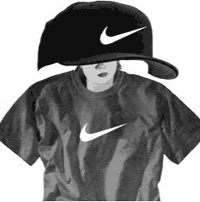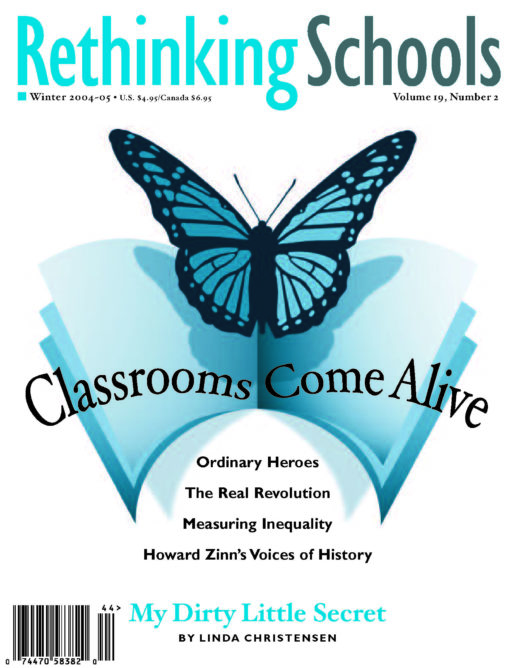My Year with Nike
A Story of Corporate Sponsorship, Branding, and Ethics in Public Schools
Illustrator: Stephen Kroninger

I teach fourth grade in Beaverton, Ore., which also happens to be the corporate headquarters of Nike, the biggest (some would say most notorious) shoe company in the world. Last year Nike selected our school to participate in a new elementary health and fitness program. Ours is a Title I school, where most kids are learning English and live in low-income homes.
Nike presented its education program as an opportunity we couldn’t refuse, especially as field trip money was scarce. They were aggressive—in daily emails and phone calls—about “partnering” with us. They would foot the bill for four field trips, including the buses. They would help us meet the state physical fitness standards. And our school would receive money for each hour spent at the Nike Campus, to be used for new P.E. equipment.
The offer smelled of marketing and public relations to me, but our school chose to participate with little hesitation. The staff had varying levels of discomfort with the proposal, but it involved free field trips, so most people greeted it with enthusiasm. Had I refused, I would have been faced with the daunting task of planning and funding at least four alternative field trips so my students wouldn’t rise up against me when they were the only fourth grade class left behind.
This wasn’t the first time I had questioned my school’s corporate connections. The previous teaching year I had refused to participate in our school’s McTeacher’s Night fundraiser. This program, incredibly, invited teachers and school administrators to work behind the counter at the local McDonald’s, luring students and their families to purchase a fast-food dinner. Aside from its demoralizing title, McTeacher’s Night countered almost everything I was trying to teach my students about healthy lifestyles, nutrition, and their own ecological impact. It was fairly easy for me to boycott McTeacher’s Night as it was not during school hours. But Nike’s proposed program included at least four daytime excursions, a total of 12 school hours.
During my year with Nike, a particular irony haunted me: Along with many other giant corporations, Nike operates exploitative sweatshops that keep communities poor and voiceless in some of the very countries from which my students’ families have migrated. These companies perpetuate injustice in developing countries by paying workers a minimum wage that is not a living wage. Additionally, workers can be exposed to dangerous conditions, independent unions are outlawed or attacked, and environmental regulations, when they exist at all, are not enforced.
I couldn’t help but think about these issues as I found myself interpreting for and escorting students through the pristine headquarters of a company that covers up social and environmental injustice with landscaped gardens and expensiveads.
A Swoosh for Every Child
A few days before the first field trip, 100 blue shirts with white swooshes were delivered to our classroom doors. At Nike’s request, all the children remembered to wear their new shirts. When the big day arrived, the excitement in the buses must have been audible for miles. “Wouldn’t it be great if we could get them this excited on the first day of school?” one colleagueyelled through the din. “Imagine if we could give all the kids t-shirts with our school name and mascot!”
Driving slowly through the guarded gates, we looked onto impeccably landscaped gardens full of colorful flowers and bubbling fountains. Nike employees from the Global Apparel Department were waiting for us, all smiles and cheers. Dressed from head to toe in Nike sports attire, they seemedgenuinely enthusiastic about meeting the fourth graders. The kids were divided into small groups and quickly led away to what seemed like all corners of the immense campus.
Despite glossy literature and detailed schedules, it turned out that no one in charge actually had experience working with large groups of school children. At one point, Nike group leaders escorted the students directly from a nutrition class into a huge auditorium. Nike employees handed each child a can of soda and students spent the next hour watching not-yet-released Nike commercials. They sent the teachers and most of the volunteer employees to the cafeteria for lunch, leaving 100 students in the auditorium with only a few Nike representatives. When we asked the program directors why the students were watching commercials, they told us it would help “rev them up” for their upcoming soccer game. Looking back, I wonder how we could have sat, albeit uneasily, through that catered lunch while they showed our students ads. I remember feeling powerless to say or change anything in that unfamiliar and imposing setting.
To their credit, Nike employees responded to our feedback (and my outrage) that neither soda nor commercials were appropriate for a health and fitness program. On our next field trip, students were served juice and trail mix for a snack, and there was no screen watching. This didn’t do much for my first impression of the program, though, nor quell my conviction that this was indeed a marketing and PR ploy.
Fun and Excitement
Each subsequent visit to Nike was full of fun and exciting activities like swimming, hip-hop dancing, rock climbing, yoga, and tennis. Many of my students were able to try things they might not have had a chance to do otherwise, and there wasn’t a single child who didn’t enjoy some aspect of our year with Nike. I was pleased the children were able to try these sports and get almost individual attention from the enthusiastic Nike employees. At the same time, I watched as our students were indoctrinated into a corporate culture, experiencing the lovely Nike Campus without being asked to consider where Nike products are made, who makes them, and under what conditions.
Branding the children was a not-so-hidden agenda of Nike’s “partnership” with my school. After every field trip, Nike sent each student home with a plastic bag full of trinkets and gifts—all emblazoned, of course, with the Nike swoosh. The children grabbed the gift bags as they were tossed onto the bus, arguing over the quantity and color of the items. I was reminded of scenarios where well-meaning but naïve charities throw toys or candy to children in poor countries. It felt patronizing, and at the same time I felt like nothing I could possibly do for my students could ever live up to the Nike gifts and the Nike Campus experience. Poor schools, like mine, seem especially vulnerable to states of dependency on this kind of corporate largesse.
Sizing Up Nike’s ‘Partnership’
At one point in the year the director of the Nike education program came to our school to give a career talk to students. As he was leaving, he noticed a teacher’s Adidas shoes. “I see you’re not wearing Nikes,” he said to her in front of her students, “We’ll have to do something about that. What size do you wear?” My colleague has not yet received new shoes, but the true purpose for the “partnership” was clearly exposed: marketing Nike products.
There were times during the school year—between the four much-anticipated “Nike Day” field trips and “Nike Career Day”—when, in frustrated desperation, I tried to counterbalance the one-sided perspective my students were getting from Nike. During a math lesson, for example, my class surveyed, graphed, and discussed where their sneakers were made, and I pieced together an advertising unit focusing on persuasive techniques in the media. I wanted to teach my class to think more critically about the commodities they buy and the media’s influence on their choices. Ultimately, I wanted them to see Nike from a fuller, less glamorous perspective. But I didn’t have the tools or the support to take either of those projects to any great depth. I also was not comfortable using Nike as an example for critical study. I worried that people at our school would view it as “inappropriate.”
My year with Nike was certainly not all bad. There were many positive opportunities for the students, nice volunteers, and responses from Nike to many of the comments we gave them throughout the school year (even though we never received evaluation forms nor were offered a formal feedback session).
In an era of increased budget crises, schools are frequentlypressured into working with corporate sponsors like Nike. But we don’t have to give in to a corporation’s every demand. Some districts across the country have outlawed partnerships with certain corporations whose products are deemed unhealthy for students, like soft-drink companies. In our case, if Nike representatives had met with teachers, students, and parents to design a program, it might have set a better precedent for the year. At a minimum, schools or school districts should develop guidelines for relationships with corporations so that when they are approached by a business they are prepared and more likely to get their needs met. Whatever schools decide, there must be plenty of opportunity for honest discussion and careful decision-making, always asking: What is really in the best interest of students?
Ultimately, the benefits Nike received from the education program—if only in advertising and generating brand-loyalty—far outweighed the benefits received by our school. If there is a genuine interest in supporting our community and our school, as Nike claims, they could undoubtedly afford to donate money with no commercial strings attached. They could encourage their employees to volunteer in existing community groups or schools.
I would gladly welcome into my classroom any volunteers who could read with my students—Nike shoes and all.

